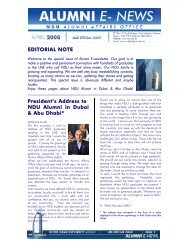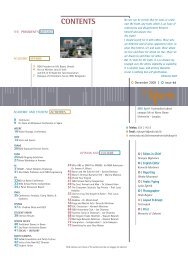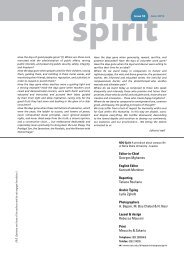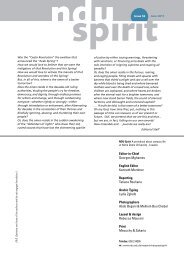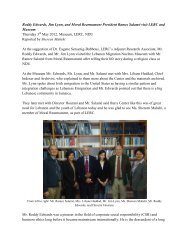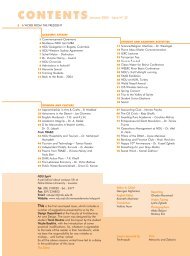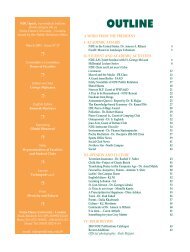Syro-Lebanese Migration - Notre Dame University
Syro-Lebanese Migration - Notre Dame University
Syro-Lebanese Migration - Notre Dame University
- TAGS
- migration
- dame
- www.ndu.edu.lb
You also want an ePaper? Increase the reach of your titles
YUMPU automatically turns print PDFs into web optimized ePapers that Google loves.
<strong>Syro</strong>-<strong>Lebanese</strong> <strong>Migration</strong> (1880-Present): “Push” and “Pull” Factors<br />
Eliane N. Fersan<br />
The earliest examples of modern <strong>Lebanese</strong> 1 migration date to the 1850s with Anthonius<br />
al-Bishalani, who migrated to the United States. However, scholars consider the<br />
1880s to be the beginning of a larger migration phenomenon. A few decades after al-<br />
Bishalani set foot in America, Michel Chiha asserted that “we could not be able to live<br />
without emigration, but if emigration became too vast, it would be the end of us.” 2 After<br />
five waves of emigration, Lebanon today faces just such a dilemma.<br />
THE FIRST WAVE: 1880-1914<br />
According to Charles Issawi, migration from Lebanon to the New World began to intensify<br />
during the second half of the 19 th century, when Mount Lebanon was the scene<br />
of several regional and international conflicts that led to civil wars, notably between<br />
Maronite Christians and the Druze in 1840 and 1860. 3 After 1861, peace also had its<br />
share in promoting migration: Missionaries founded medical dispensaries and schools<br />
that helped to reduce mortality and raise the level of education to meet the needs of a<br />
flourishing tertiary sector. This led to a demographic boom in the Mount Lebanon area,<br />
spurring an “internal exodus,” mainly to Beirut, while the number of educated people<br />
outnumbered the available jobs, pushing those who were less educated to seek employment<br />
outside Lebanon. Furthermore, Beirut’s population, which had quadrupled between<br />
1830 and 1850, doubled between 1865 and 1920, as a result of the internal exodus<br />
from the over-populated Mount Lebanon area. 4<br />
The Mutasarifiate brought new challenges: The new political regime allowed free trade,<br />
which led to an influx of European goods into the <strong>Lebanese</strong> market. As a result, Mount<br />
Lebanon’s economy shifted rapidly from an autarchic regime to enmeshment with the<br />
world economy, which required the use of cash whereas <strong>Lebanese</strong> relied on barter and<br />
exchange of goods. Peasants tried to compensate for this deficiency by taking personal<br />
loans to buy mulberry trees, necessary for the production of silk — then the backbone<br />
of the <strong>Lebanese</strong> economy, accounting for 82% of Mount Lebanon’s exports. 5 At that<br />
time, 40% of cultivated land was allocated to growing mulberry trees. This resulted in<br />
an export-driven monoculture, 6 and Mount Lebanon had to resort to importing raw<br />
foodstuffs such as wheat in a period of demographic expansion and heavy debts. In<br />
1. The early migration from the Ottoman occupied lands was mainly from Lebanon. However, <strong>Lebanese</strong><br />
were first registered in official records of ports of entry as Turks, as they held Turkish passports.<br />
Therefore, the term “<strong>Syro</strong>-<strong>Lebanese</strong>” is the proper term to refer to the pre-Mandate era, taking into<br />
account that the majority of migrants originated from modern day Lebanon.<br />
2. Michel Chiha, Lebanon at Home and Abroad, Leo Arnold and Jean Montegu, trans. (Beirut: The<br />
Publications of the Cenacle, 1966), p. 114.<br />
3. Charles Issawi, “The Historical Background of <strong>Lebanese</strong> Emigration: 1880-1914,” in Albert H.<br />
Hourani and Nadim Shehadi, eds., The <strong>Lebanese</strong> in the World: A Century of Emigration (London: I.B.<br />
Tauris, 1993), pp. 13-31.<br />
4. Leila Tarazi-Fawaz, Merchants and Migrants in Nineteenth-Century Beirut, Harvard Middle Eastern<br />
Studies, No. 18 (Cambridge, MA: Harvard <strong>University</strong> Press, 1983), pp. 2-3.<br />
5. Akram Khater, “‘House to Goddess of the House’: Gender, Class and Silk in the 19 th Century Mount<br />
Lebanon,” International Journal of Middle East Studies, Vol. 28, No. 3 (1996), pp. 326-27.<br />
6. Boutros Labaki, “L’émigration libanaise en fin de période ottomane (1850-1914),” Hannon Revue<br />
Libanaise de Géographie, Vol. 19 (1987), p. 9.<br />
Eliane N. Fersan, holds a<br />
Master 2 in History from<br />
Université Saint Esprit de<br />
Kaslik and is an Associate<br />
Researcher at the <strong>Lebanese</strong><br />
Emigration Research Center<br />
at <strong>Notre</strong> <strong>Dame</strong> <strong>University</strong>–<br />
Louaize in Lebanon. She<br />
conducted extensive research<br />
and indexing on the E-Levant<br />
series of the archives<br />
of the Ministry of Foreign<br />
Affairs of France as well as<br />
the Maronite Patriarchal Archives<br />
of Bkerke. She also has<br />
conducted research on early<br />
<strong>Lebanese</strong> migration and the<br />
naturalization process under<br />
the French Mandate. She is<br />
currently active in the field of<br />
sustainable development, democracy,<br />
and human rights.<br />
Email: efersan@ldu-lb.org<br />
Middle East Institute Viewpoints • www.mei.edu 13
Fersan...<br />
1890, 18 years after the silk boom, the economy was heavily challenged: A “silk crisis” occurred, as cheaper and better<br />
quality Chinese silk products flooded European markets, previously the main destination for <strong>Lebanese</strong> silk.<br />
This crisis corresponded with the 19 th -century coastal revival, “owing to growth of trade with Europe following the<br />
industrial revolution and the development of steam navigation.” At least ten steam navigation lines operated regularly<br />
from the port of Beirut. Migrants could thus easily go back and forth, carrying home success stories from America and<br />
attracting more young, and ambitious but unskilled men seeking wealth and prosperity in the New World. 7<br />
However, seeking a better life was not the only motive for migration; a large number of<br />
young men fled conscription. Hitti asserts that every steamer heading to the Americas<br />
was full of young men seeking to avoid military service. 8 Here Christian residents of<br />
the wilayets of Beirut, Saida, and Tripoli were the direct targets, as Christians of the<br />
Mutassarifiate were granted a special status guaranteed by the Règlement Organique. 9<br />
14<br />
Seeking a better life<br />
was not the only motive<br />
for migration.<br />
“It was like a gold rush,” as steamship agents — usually returning migrants who marketed their success stories in the<br />
New World — “recruited passengers for the ships in form of cheap labor for America’s industries.” 10 High-interest credit<br />
was offered to those who could not afford to buy a ticket. 11<br />
Red-tiled Italian-style houses were seen all over the mountain; everywhere, signs of prosperity and wealth encouraged<br />
young men to emigrate, leading to an “emigration fever.” 12 About 45% of Mount Lebanon’s population is said to have<br />
emigrated between 1860 and 1914; Mount Lebanon’s population in 1913 is estimated to have been 468,714. 13<br />
The irreversible Occidental orientation of Lebanon, as described by Karam Rizk, also was encouraged by the missionary<br />
schools, which introduced Western culture to <strong>Lebanese</strong> society. Meanwhile, foreign languages were taught and spoken<br />
in the streets of Beirut, 14 attracting yet more <strong>Lebanese</strong> youth to the West.<br />
Egypt was the first destination for <strong>Syro</strong>-<strong>Lebanese</strong>, who were drawn there by its prosperous economy and the freedom of<br />
speech promoted under British tutelage. Later on, two large exhibitions held in Philadelphia in 1876 and in Chicago in<br />
1893 had a significant influence on migration, as the Ottoman Empire favored wider participation and representation<br />
of the Sultanate in these exhibitions and therefore encouraged <strong>Syro</strong>-<strong>Lebanese</strong> to participate. 15<br />
It was the economic growth in the Americas that had a direct impact on migration: <strong>Syro</strong>-<strong>Lebanese</strong> were “pulled” by the<br />
opportunities that were offered in the United States, which had the highest growth rate of income per capita among<br />
industrial countries (4.3% per annum) between 1879 and 1913. 16<br />
7. Tarazi-Fawaz, Merchants and Migrants in Nineteenth-Century Beirut, p. 2.<br />
8. Philip Hitti, The Syrian in America (New York: George H. Doran Company, 1924), p. 51.<br />
9. Abdallah Al-Mallah, “Mount Lebanon Mutassarifate Between 1903 and 1915: The Global Political and Sociological Reality,” PhD dissertation,<br />
Fanar, <strong>Lebanese</strong> <strong>University</strong>, Section II, 1990, p. 11.<br />
10. F. Kleem, “The Cleveland Maronite <strong>Lebanese</strong> and Education,” PhD dissertation, Cleveland, Ohio, 1986, p. 20, cited in Louis Ferkh,<br />
“Conflict and <strong>Migration</strong>: The <strong>Lebanese</strong> Emigrants’ Potential Role in the Development of Lebanon,” PhD dissertation, <strong>University</strong> of Limerick,<br />
1991, p. 84.<br />
11. Hitti, The Syrian in America, p. 53.<br />
12. Ferkh, “Conflict and <strong>Migration</strong>: The <strong>Lebanese</strong> Emigrants’ Potential Role in the Development of Lebanon,” p. 84.<br />
13. Youssef Courbage and Philippe Fargues, La situation démographique du Liban, Analyses et données (Beirut : publication du Centre de<br />
Recherches de l’Institut des Sciences Sociales de l’Université Libanaise, 1974), cited in Boutros Labaki, “L’émigration libanaise en fin de<br />
période ottomane (1850-1914),” pp. 8, 15.<br />
14. Rev. Karam Rizk, “Vie spirituelle et culturelle au Liban de 1845 à 1870,” Parole de l’Orient, Vol. 15 (1988/89), pp. 321-322.<br />
15. Alixa Naff, “<strong>Lebanese</strong> Immigration into the United States: 1880 to the Present,” in The <strong>Lebanese</strong> in the World: A Century of Emigration<br />
(Oxford: The Center for <strong>Lebanese</strong> Studies, 1922), p. 144.<br />
16. Boutros Labaki, “L’émigration libanaise en fin de période ottomane (1850-1914),” p. 14.<br />
Middle East Institute Viewpoints • www.mei.edu
Fersan...<br />
The rubber boom in Brazil also attracted migrants in the 1890s. Demography was an essential catalyst, as the underpopulated<br />
American continent offered opportunities for both skilled and unskilled migrants. In Brazil, the abolition of<br />
slavery allowed <strong>Lebanese</strong> to find work as peddlers, selling goods in the Brazilian hinterlands. 17<br />
Freedom of speech also was an essential “pull” factor — attracting immigrants to the United States, Canada, Brazil, Argentina,<br />
and other Latin American countries. <strong>Lebanese</strong> migrants, according to Hitti, “hardly […] fail to refer to [their]<br />
desire […] to live [a] life free and unhampered from political restraints as the chief motive for [their] coming into<br />
the United States.” 18 This could be the reason behind the founding of several Arabic magazines in the New World addressing<br />
Mount Lebanon and issues of the homeland. The number of newspapers and magazines surpassed that in the<br />
Mutasarifiate. 19 Chiha attributes <strong>Syro</strong>-<strong>Lebanese</strong> emigration to “the ingenuity of the Near Easterner [which] is a basic<br />
element in his assets — an integral part of his stock-in-trade; and this ingenuity becomes effective only outside or above<br />
regulations and restraint.” 20<br />
This first wave of <strong>Syro</strong>-<strong>Lebanese</strong> immigrants — most of whom were illiterate, unskilled,<br />
and single males — remitted large sums of money that helped balance Mount Lebanon’s<br />
economy and contributed to the decongestion of the cities by reducing the toll of<br />
unemployment — the direct outcome of rural exodus.<br />
THE SECOND WAVE: 1915-1945<br />
The First World War sea blockade halted emigration for three years (1915-18), but the<br />
outflow of <strong>Lebanese</strong> resumed as soon as the war ended. Emigration continued until<br />
the third quarter of 1920 and the proclamation of the French Mandate over Lebanon.<br />
Thereafter, a series of factors dramatically reduced the number of emigrants: the<br />
US quota for immigration, the stability brought to Lebanon by the French Mandate,<br />
and the international economic crisis — the Great Depression — that swept through<br />
the United States and Europe. The French Higher Commissioners report a significant<br />
number of returnees in 1924, 1927, and 1928. 21 This new trend, however, did not last.<br />
The year 1925 saw an increase in migration, as the Druze insurrection in Syria quickly<br />
spread to Lebanon and resulted in clashes, notably in the Christian Beqaa town of Ra-<br />
shaya. These incidents reminded the Christians of the 1840 and 1860 massacres. It also undermined their trust in the<br />
French Mandatory powers to help them secure an independent <strong>Lebanese</strong> entity. Lebanon’s economy continued to suffer<br />
from the destruction and high mortality rate of the First World War. Meanwhile, France faced an enormous economic<br />
crisis. These circumstances prevented investment in the building of Lebanon’s economy and attracting successful <strong>Lebanese</strong><br />
migrant capitalists.<br />
This wave of migration included a significant increase in the number of women, who deaprted primarily for purposes<br />
of family reunion. This wave also included new destinations for <strong>Lebanese</strong> migrants, such as Australia and West Africa.<br />
THE THIRD WAVE: 1943-1975<br />
This first wave of<br />
<strong>Syro</strong>-<strong>Lebanese</strong> immigrants<br />
— most<br />
of whom were illiterate,<br />
unskilled,<br />
and single males<br />
— remitted large<br />
sums of money<br />
that helped balance<br />
Mount Lebanon’s<br />
economy and contributed<br />
to the decongestion<br />
of the<br />
cities ...<br />
Although migration waned immediately after Lebanon achieved independence, this trend did not prevail. Starting in<br />
17. Jeff Lesser, “From Peddlars to Proprietors: <strong>Lebanese</strong>, Syrian and Jewish Immigrants to Brazil,” in The <strong>Lebanese</strong> in the World, pp. 395-<br />
401.<br />
18. Hitti, The Syrian in America, p. 51.<br />
19. Hitti, The Syrian in America, p. 135.<br />
20. Chiha, Lebanon at Home and Abroad, p. 119.<br />
21. M.A.E., rapport à la SDN pour l’année 1927, p. 53. M.A.E., rapport à la SDN pour l’année 1925, p. 95. M.A.E., rapport à la SDN pour<br />
l’année 1927, p. 89. M.A.E., rapport à la SDN pour l’année 1928, p. 94.<br />
Middle East Institute Viewpoints • www.mei.edu 15
Fersan...<br />
the 1950s, political unrest, a high cost of living, and a high rate of unemployment drove more <strong>Lebanese</strong> to emigrate.<br />
Further spurring emigration were the 1956 Suez crisis, political persecution, discrimination following the unsuccessful<br />
coup attempt by the Syrian Social Nationalist Party, the 1967 Arab-Israeli War, and Israel’s daily raids in South Lebanon<br />
in an attempt to crush Palestinian guerrillas attacking northern Israel.<br />
As a result of instability, 164,000 <strong>Lebanese</strong> fled the country between 1973 and 1974: 72,000 to the Arab countries, 64,000<br />
to Europe, 21,000 to the United States, 1,600 to Australia, 61,000 to Africa, and 17,000 to Asian countries. 22<br />
Yet, despite the amplitude of the number of migrants in 1973-1974, emigration during this period was far less impressive<br />
than the first wave. At the same time, the migrants’ profile changed significantly: Young men and women seeking<br />
better education migrated to the United States, Canada, and Europe, while those who sought employment opportunities<br />
migrated to the Gulf in the “oil boom” era. 23<br />
THE FOURTH WAVE: 1975-1990<br />
During this 15-year period, which was marked by civil war, approximately one million<br />
<strong>Lebanese</strong> fled the country. 24 Labaki asserts that at the beginning of the civil war, most<br />
migrants returned as soon as the situation returned somewhat to normalcy (in 1976),<br />
while a large number continued to go back and forth. After 1985, however, migration<br />
became permanent. 25<br />
It is not surprising that war and its effects were the major “push” factors during this period. According to the Centre<br />
Catholique d’Information, over 800,000 families were displaced. 26 This massive internal movement was followed by an<br />
economic crisis, the devaluation of the <strong>Lebanese</strong> lira, and a dramatic rise in the unemployment rate, which reached<br />
35% in 1987. 27 The breakdown of the educational system prompted youth and family migration, as <strong>Lebanese</strong> families<br />
traditionally accorded great importance to education. 28<br />
Reunion Acts pulled many families to join their relatives abroad. However, terrorist attacks in Beirut led to worldwide<br />
scrutiny of all <strong>Lebanese</strong>; consequently, visa procedures became much more difficult. This prompted all those who had<br />
relocated temporarily to work to acquire new nationalities in their host countries. Lebanon thus lost these migrants for<br />
good. 29<br />
THE FIFTH WAVE: 1990-PRESENT<br />
16<br />
Nowadays, <strong>Lebanese</strong><br />
migration is<br />
mainly a process of<br />
“brain drain.”<br />
Nowadays, <strong>Lebanese</strong> migration is mainly a process of “brain drain” whereby the most educated men and women seek<br />
better jobs and opportunities abroad. During the period of Syrian hegemony over Lebanon (1990-2005), corruption,<br />
inflation, an increase in public debt, and political persecution prevented many <strong>Lebanese</strong> from returning and prompted<br />
many among those who had stayed to leave. Unemployment gutted the middle class, which adversely affected the <strong>Lebanese</strong><br />
economy as a whole. Twenty-eight percent of <strong>Lebanese</strong> families lived below the absolute poverty line. 30 Meanwhile,<br />
22. Al-Minbar, No. 49, March 1990, p. 16.<br />
23. Nabil Harfouch, The <strong>Lebanese</strong> in the World, Documents and Censuses, Vol. III, Beirut, 1978, p. 24.<br />
24. Ferkh, “Conflict and <strong>Migration</strong>: The <strong>Lebanese</strong> Emigrants’ Potential Role in the Development of Lebanon,” p. 88.<br />
25. Boutros Labaki, “L’émigration libanaise en fin de période ottomane (1850-1914),” p. 607.<br />
26. Joseph Khoreich, Results of the <strong>Lebanese</strong> War 1975-1997, Liban, Centre Catholique d’Information, p. 7.<br />
27. Salim Nasr, “The Political Economy of the <strong>Lebanese</strong> Conflict,” in Nadim Shehadi and Bridget Harney, eds., Politics and the Economy in<br />
Lebanon (Oxford: The Center for <strong>Lebanese</strong> Studies, 1989), pp. 42-50.<br />
28. Ferkh, “Conflict and <strong>Migration</strong>: The <strong>Lebanese</strong> Emigrants’ Potential Role in the Development of Lebanon,” pp. 90-95.<br />
29. Ferkh, “Conflict and <strong>Migration</strong>: The <strong>Lebanese</strong> Emigrants’ Potential Role in the Development of Lebanon,” p. 100.<br />
30. Antoine Haddad, “The Poor in Lebanon,” The Lebanon Report, No. 3 (1996), p. 1.<br />
Middle East Institute Viewpoints • www.mei.edu
Fersan...<br />
each year, 50,000 new job seekers competed in the <strong>Lebanese</strong> labor market for 35,000 new jobs. 31<br />
The repeated Hizbullah/Israel clashes resulted in continuous political and security unrest. The most recent conflict,<br />
which occurred in 2006, sowed doubt among young men and women that a safe and prosperous Lebanon was achievable.<br />
In her latest field research, Choghig Kasparian demonstrates that obtaining work motivates 52.4% of those who<br />
decide to migrate, education 8.8%, family reasons 25.4%, and other factors, including security and politics 13.4%. 32 The<br />
proportion of men who have migrated (22.9%) is slightly more than double that of women (11.5%), 33 which is widening<br />
the demographic gap between the sexes.<br />
Recently, the <strong>Lebanese</strong> government has devoted more attention to immigrants’ needs.<br />
<strong>Lebanese</strong> politicians are constantly making visits to the Mahjar (Arab diaspora), taking<br />
into account that the remittances are undoubtedly the strongest bulwark against the<br />
collapse of the <strong>Lebanese</strong> economy in the face of the worldwide economic crisis.<br />
With the lack of legislation favoring investments by migrants in Lebanon, this chain<br />
of support from remittances can be easily broken, once the family ties are lost, notably<br />
as families relocate to the West, Australia, and even Africa. Some migration specialists<br />
claim that this trend is not applicable to the majority of <strong>Lebanese</strong> migrants to the Gulf,<br />
as it is a short-term migration with no possibility of permanent residence. However, the<br />
latest trends show that a large number of those in the Gulf are seeking re-emigration<br />
to the West in the light of the ongoing corruption and instability in Lebanon. Thus<br />
far, Lebanon has failed to reverse the Brain Drain and convert it to a Brain Gain. The<br />
departure of many of the best and brightest <strong>Lebanese</strong> men and women is mortgaging<br />
the country’s future.<br />
Recently, the <strong>Lebanese</strong><br />
government<br />
has devoted more<br />
attention to immigrants’<br />
needs ...<br />
[but] ... the departure<br />
of many of the<br />
best and brightest<br />
<strong>Lebanese</strong> men and<br />
women is mortgaging<br />
the country’s<br />
future.<br />
31. Kamal Hamdan, “Economist Slams Policies,” Alternative-Online, Lebanon, Vol. 1, No. 7 (2003), p. 3A.<br />
32. Choghig Kasparian, “Les jeunes libanais dans la vague d’émigration de 1992-2007,” L’émigration des jeunes libanais et leurs projets d’avenir,<br />
Vol. 2, PUFJ (2009), p. 24.<br />
33. Kasparian, “Les jeunes libanais dans la vague d’émigration de 1992-2007,” p. 15.<br />
Middle East Institute Viewpoints • www.mei.edu 17



